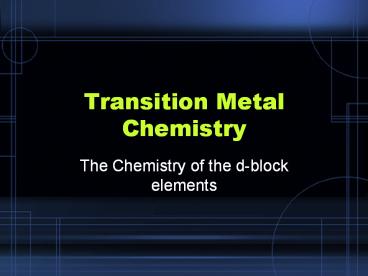Transition Metal Chemistry - PowerPoint PPT Presentation
Title:
Transition Metal Chemistry
Description:
Transition Metal Chemistry The Chemistry of the d-block elements The Periodic Table Electronic configurations The two exceptions Ions Transition metals are defined as ... – PowerPoint PPT presentation
Number of Views:557
Avg rating:3.0/5.0
Title: Transition Metal Chemistry
1
Transition Metal Chemistry
- The Chemistry of the d-block elements
2
The Periodic Table
p
s
d
3
Electronic configurations
Using the aufbau principle
1s2, 2s2, 2p6, 3s2, 3p6, 4s2, 3d1
1s2, 2s2, 2p6, 3s2, 3p6, 4s2, 3d10
1s2, 2s2, 2p6, 3s2, 3p6, 4s2, 3d6
4
The two exceptions
You would expect Chromium to have the electronic
configuration 1s2, 2s2, 2p6, 3s2, 3p6, 4s2,
3d4 But in fact it has the configuration 1s2,
2s2, 2p6, 3s2, 3p6, 4s1, 3d5 There is a special
stability associated with half-filled and full
sub-shells. Copper
1s2, 2s2, 2p6, 3s2, 3p6, 4s1, 3d10
5
Ions
- Transition metals are defined as metallic
elements with an incomplete d sub-shell in at
least one of their ions. - Form positive () ions by losing electrons.
- These electrons come from the 4s sub-shell first,
then from the 3d sub-shell
Fe atom
1s2, 2s2, 2p6, 3s2, 3p6, 4s2, 3d6
Fe2 ion
1s2, 2s2, 2p6, 3s2, 3p6, 3d6
6
Complex Ions and Complexes
- Understanding Transition metal compounds
7
In aqueous solution
- Transition metal ions exist as complex ions in
aqueous solution, e.g.
Co(H2O)62
What shape is this?
8
(No Transcript)
9
Ligands
Formed through donation of electron
pairs Coordinate covalent bond
The water molecules are an example of
ligands LIGAND molecules or anions which attach
to the metal atom in a complex via coordinate
(dative) covalent bonds Number of bonds formed
with ligands COORDINATION NUMBER Assemble is
known as a COMPLEX ION So instead of existing in
solution as free ions, e.g. Cu2, exist as
complex ions, Cu(H2O)52
10
Shapes of complex ions
11
Naming ligands
Ligand Name
Bromide Carbonate Cyanide Hydroxide Ammonia Carbon monoxide Water Bromo Carbonato Cyano Hydroxo Ammine Carbonyl Aqua
12
Categories of ligand
- MONODENTATE LIGAND the ligand bonds to the metal
using one atom - POLYDENTATE LIGANDS the ligand bonds to the
metal using more than one atom
13
(No Transcript)
14
Common Examples
Chlorophyll
Haemoglobin
15
Determining coordination number
Number of bonds formed with ligands
COORDINATION NUMBER
Complex ion Coordination number
Ag(NH3)2 HgI3- W(CO)64 2 3 6
6 is the most common coordination number
16
Forming a complex
- The cation or anion cannot exist on their own and
must have their charges balanced - The complex ion will bond with oppositely charged
ions to form a complex
Complex Cation Anion
Pt(NH3)6Cl4 Pt(NH3)4Cl2Cl2 K4Fe(CN)6 Pt(NH3)64 Pt(NH3)4Cl22 K Cl- Cl- Fe(CN)64-
17
Naming Coordination Compounds
- Cation precedes anion
- Complex ion names are one word ligands first,
then metal - Ligands will have a Greek prefix in front
- If the complex ion is an anion, it ends in -ate
- The metal name is followed by the oxidation state
in Roman Numerals
18
Old vs New
- CuSO45H2O vs Cu(H2O)5SO4
- Copper(II) sulphate pentahydrate
- Pentaaquacuprum(II) sulphate
19
Colour in Transition Metal Compounds
20
Why coloured?
Transition metal ions are often coloured They
absorb EM radiation because of loss of degeneracy
of d-orbitals Those which absorb in the visible
region will appear the complementary colour
21
- The 5 d-orbitals in an isolated atom are
degenerate - Ligands cause the d-orbitals to become
non-degenerate - Different ligands cause different splitting
effects
22
Crystal field splitting (energy), ?
23
In an octahedral complex, the ligands lie on the
x, y and z axis Their electrons have a greater
repulsive effect on the d-orbitals which lie on
the same axis
24
Spectrochemical Series
- An arrangement of ligands according to the
relative magnitudes of the crystal field
splittings they induce in the d-orbitals of a
metal ion - I-lt Br-lt Cl- lt F- lt OH- lt H2O lt NH3 lt NO2- lt CN-
lt CO
Weak-bonding ligands
Strong-bonding ligands
Increasing ?
Therefore, different ligands will result in
different colours
25
Gemstones
Cr3 in Al2O3
Cr3 in Be3Al2(SiO3)6
26
Catalysis
- Transition metals as catalysts
27
- Catalysts provide an alternative pathway with a
lower activation energy - Transition metals can use half-filled or empty
orbitals to form intermediate complexes (e.g. 4p) - They can change oxidation state during a
reaction, then revert back to their original state































